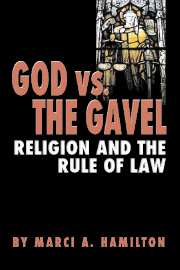Book contents
- Frontmatter
- Contents
- Acknowledgments
- Foreword, by the Hon. Edward R. Becker
- GOD VS. THE GAVEL: RELIGION AND THE RULE OF LAW
- PART ONE WHY THE LAW MUST GOVERN RELIGIOUS ENTITIES
- PART TWO THE HISTORY AND DOCTRINE BEHIND THE RULE THAT SUBJECTS RELIGIOUS ENTITIES TO DULY ENACTED LAWS
- 8 Boerne v. Flores: The Case That Fully Restored the Rule of Law for Religious Entities
- 9 The Decline of the Special Treatment of Religious Entities and the Rise of the No-Harm Rule
- 10 The Path to the Public Good
- Epilogue
- Notes
- Index
8 - Boerne v. Flores: The Case That Fully Restored the Rule of Law for Religious Entities
Published online by Cambridge University Press: 24 July 2009
- Frontmatter
- Contents
- Acknowledgments
- Foreword, by the Hon. Edward R. Becker
- GOD VS. THE GAVEL: RELIGION AND THE RULE OF LAW
- PART ONE WHY THE LAW MUST GOVERN RELIGIOUS ENTITIES
- PART TWO THE HISTORY AND DOCTRINE BEHIND THE RULE THAT SUBJECTS RELIGIOUS ENTITIES TO DULY ENACTED LAWS
- 8 Boerne v. Flores: The Case That Fully Restored the Rule of Law for Religious Entities
- 9 The Decline of the Special Treatment of Religious Entities and the Rise of the No-Harm Rule
- 10 The Path to the Public Good
- Epilogue
- Notes
- Index
Summary
From the 1960s into the 1990s, law schools taught two constitutional principles that were largely unquestioned; one might even say they were articles of faith. First, no government could enforce a law against a religious believer unless the government could prove that its law was passed for a compelling interest. Second, Congress held the power to increase constitutional rights at will. A generation of law students was taught that these principles were self-evident from the Constitution and Supreme Court cases.
In 1990, the U.S. Supreme Court rejected the first principle, and in 1997, it rejected the second. This chapter will explain the developments that led to what seemed to many like a revolution at the Court, but was less of a cataclysmic doctrinal shift than a conscious choice between internally inconsistent doctrines. In fact, in both categories, the four decades between 1960 and 2000 were a time when the Court straddled sometimes conflicting doctrinal approaches. Facing an either/or choice in each category, the Court in the 1990s did not so much invent new doctrines as it chose to excise doctrines that were causing friction. A 1997 Supreme Court case confirmed that the Court had made a definitive choice in each area. That case is City of Boerne v. Flores, Archbishop of San Antonio.
The two issues – free exercise protection and the power of Congress – typically belong in separate constitutional domains.
- Type
- Chapter
- Information
- God vs. the GavelReligion and the Rule of Law, pp. 203 - 237Publisher: Cambridge University PressPrint publication year: 2005

